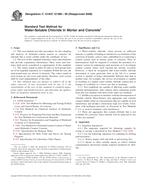Potřebujeme váš souhlas k využití jednotlivých dat, aby se vám mimo jiné mohly ukazovat informace týkající se vašich zájmů. Souhlas udělíte kliknutím na tlačítko „OK“.
ASTM C1218/C1218M-99(2008)
Standard Test Method for Water-Soluble Chloride in Mortar and Concrete
Automaticky přeložený název:
Standardní zkušební metoda pro rozpustný ve vodě chloridů v malt a betonů
NORMA vydána dne 1.1.2008
Informace o normě:
Označení normy: ASTM C1218/C1218M-99(2008)
Poznámka: NEPLATNÁ
Datum vydání normy: 1.1.2008
Kód zboží: NS-10083
Počet stran: 3
Přibližná hmotnost: 9 g (0.02 liber)
Země: Americká technická norma
Kategorie: Technické normy ASTM
Anotace textu normy ASTM C1218/C1218M-99(2008) :
Keywords:
chloride, chloride content, concrete, mortar, water-soluble chloride, Chloride analysis--concrete/aggregate, Concrete, Corrosion--concrete, Hydraulic cement mortar, Mortar, Water-soluble chloride, ICS Number Code 91.100.10 (Cement. Gypsum. Lime. Mortar)
Doplňující informace
| Significance and Use | ||||||||||||||||
|
Water-soluble chloride, when present in sufficient amount, is capable of leading to initiation or acceleration of the corrosion of metals, such as steel, embedded in or contacting a cement system such as mortar, grout, or concrete. Thus, its determination shall be required to evaluate the potential of a cement system for undergoing such reactions or to investigate cement systems where such reaction has already occurred. However, it must be recognized that water-soluble chloride determined at some particular time in the life of a cement system is capable of being substantially different than that at another time; for example, the service environment is capable of resulting in a higher water-soluble chloride content due to changes in solubility or a lower one due to leaching. Test conditions are capable of affecting water-soluble chloride determinations. Take caution when comparing results from this test method with those from other test methods. Sulfides are known to interfere with the determination of chloride content. Blast-furnace slag aggregates and cements contain sulfide sulfur in concentrations that are capable of such interference and produce erroneously high test results. Treatment with hydrogen peroxide, as discussed in Test Methods C 114, is used to eliminate such interference. There are aggregates that contain chloride that is not available for corrosion. Such chloride will be detected by use of this test method. |
||||||||||||||||
| 1. Scope | ||||||||||||||||
|
1.1 This test method provides procedures for the sampling and analysis of hydraulic-cement mortar or concrete for chloride that is water soluble under the conditions of test. 1.2 The text of this standard references notes and footnotes that provide explanatory information. These notes and footnotes shall not be considered as requirements of this standard. 1.3 The values stated in either SI units or inch-pound units are to be regarded separately as a standard. Within the text, the inch-pound units are shown in brackets. The values stated in each system are not exact equivalents; therefore, each system shall be used independently of the other. 1.4 This standard does not purport to address all of the safety concerns, if any, associated with its use. It is the responsibility of the user of this standard to establish appropriate safety and health practices and determine the applicability of regulatory limitations prior to use. |
||||||||||||||||
| 2. Referenced Documents | ||||||||||||||||
|




 Cookies
Cookies
